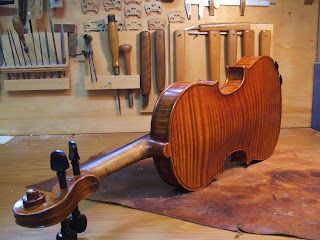The last post about my former self mentioned that some old images of instruments were lost, but now some are found. There may not be a particular interest in them, but like in that last post, I include them to keep as a digital record of a particular mission that I was on at the time.
When beginning with violin family instruments I made and used a particular varnishing system well-known to those luthiers who like to create their own finishes. It was a spirit based system from a recipe dating back to the early 1700's, and it used several gums, oils and lacs. It had the advantage of being quick to dry and fairly hard wearing (in the absence of alcohol) and was commercially useful, but the ground under the varnish never looked right.
This led to a lot of research into the very old ways of doing things, and rather than looking for a 'secret' (which everyone seems to think is at the bottom of great instrument sound) I read up on the trades and traditions of the guild workers who had such an influence all over Italy- The Byzantine Greeks, who revolutionised almost all trade work before the renaissance. I'm not going to try to summarise that whole story, but it became obvious that many trades shared a set of procedures in the application of coatings, including furniture makers, guilders, carriage builders, church fitters, instrument makers amongst others.
One of the reasons that there was commonality amongst them was fashion. The fashion for a gold appearance either as a finish, or as a reflective surface under a translucent finish. This is the quality that underlies the great Italian violin family masterpieces. The effect is a consequence of practical considerations as well as visual ones, and by identifying the common materials used in the ground layer (the solid base upon which the coloured layers are placed) it was possible to create a more golden, sparkly, subtle, impossible to photograph sensibly without looking like a complete nutter, and dependable surface that could be relied upon to be a consistent contributor to stiffness in the vibrating plates (the back and the belly)
The down side was that this stuff needed to be built into oil based coatings, and I ended up applying them with thumbs rather than a brush, and they took a long time to dry. I had to make a UV drying cupboard, but the system still took as long to do as it took to build the instrument. But it did look lovely under lighting from different directions....and these pics were my attempts to capture on film what excited my eyes so much, but of course they end up just looking like a bunch of violins.
The conception of a fine instrument is much more than an accurate outline. A beautiful varnish is more than a pleasant colour. Successful arching can only function in a direct relationship to the thicknessing and the varnish. A well cut f hole is conceived with reference to arch, outline, body length, placement and it's effect on the resonant frequencies of the corpus. Masterful work holds these things and others in harmonic balance.
Some of my stash of very old hand cut and air dried Bosnian maple. Just gorgeous...These are for one-piece backs that you will spot in a couple of the violins pictured above.
I found this little slideshow originally made around 2005 I think (although I have shortened it in case there are people out there who don't like looking at paint drying)....but if you do, then try it on a big screen so you can become bored in real style.










No comments:
Post a Comment